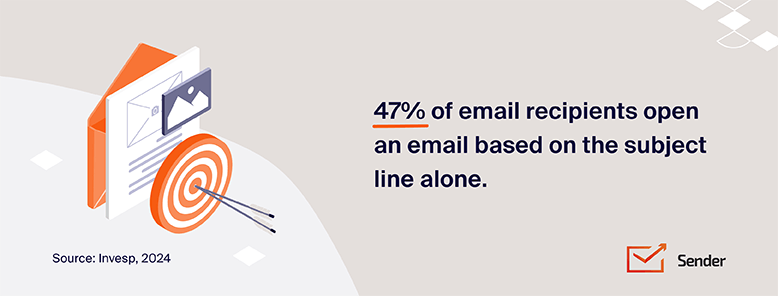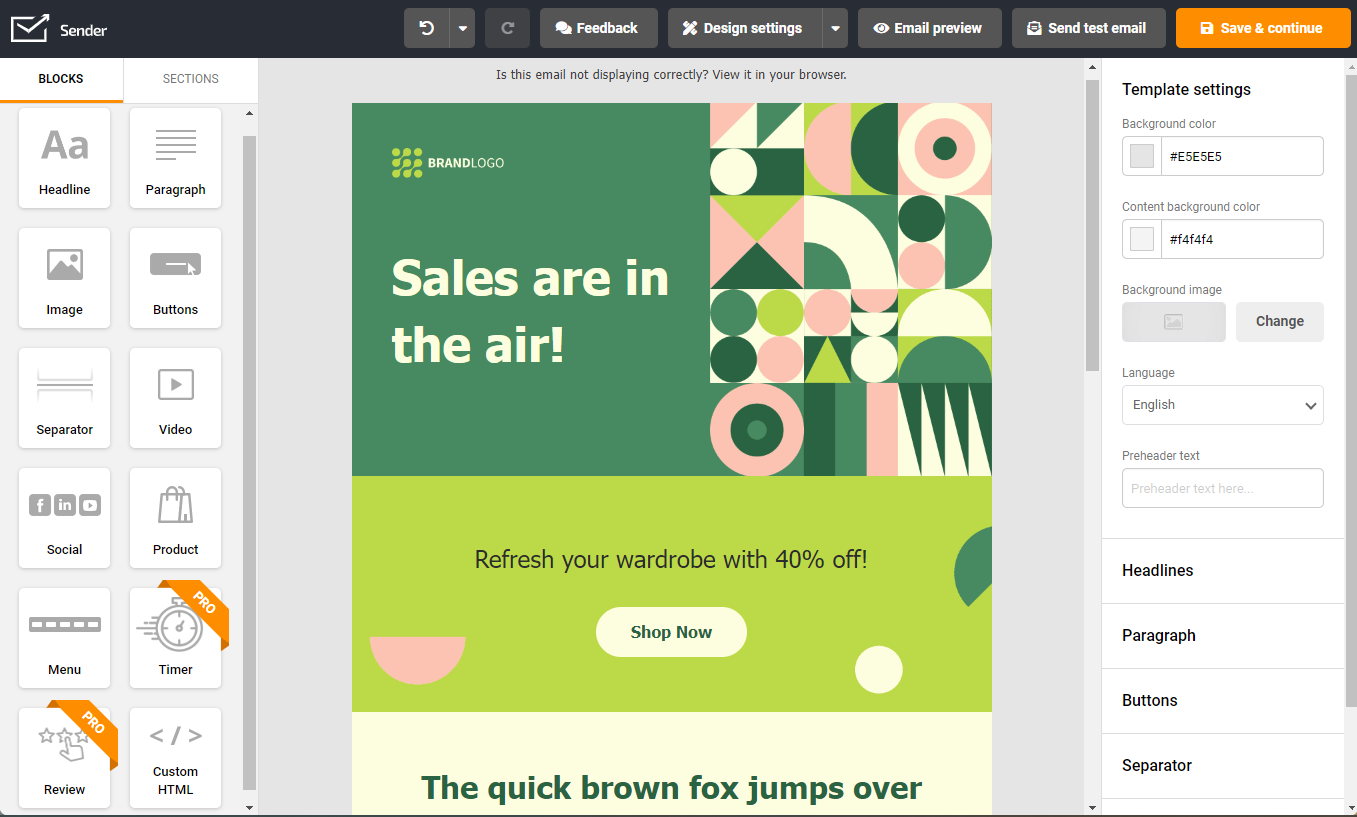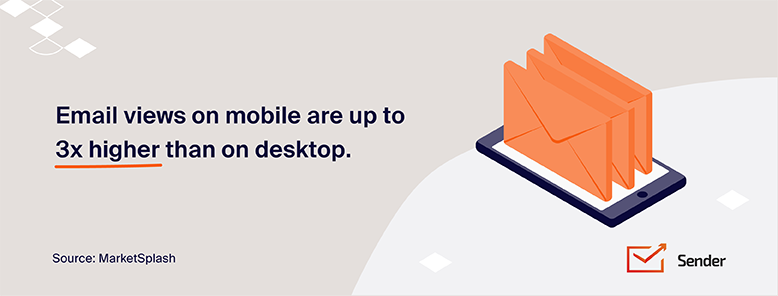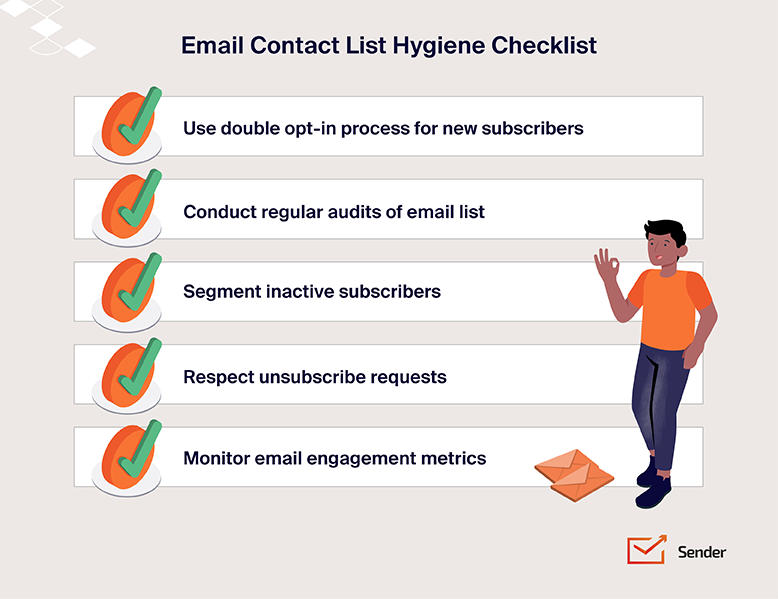Wondering what it would take to improve your open rates? You’re not alone. Almost every business owner and marketer wants to achieve high open rates. But do you know what benchmark to use to compare your open rates? Which industries get the highest open rates?
Most importantly, how to improve your open rates? In this blog, we’ll cover the open rate metric in-depth and share some proven strategies to improve your open rates. So, hang tight and read on because it will help you improve your marketing efforts.
Let’s begin.
What is Email Open Rate?
Your email open rate signifies how many subscribers open your email. Basically, it’s the percentage of recipients who opened your email from your entire subscriber list.
Let’s say you sent an email to 100 people. 46 people opened your email, so your open rate is 46%.
Open rates tell how many people are interested in your newsletters and is the first step towards building a successful email marketing strategy. Because no matter what you add to your email marketing campaign, if they don’t open it, they won’twitness what’s next from your side.
How Email Open Rates are Calculated?
Your open rates are based on the number of emails that landed in the inbox and unique opens. To calculate the open rate, you need the following figures:
- The number of emails sent;
- Bounced emails or emails not delivered;
- Unique opens;
Once you have these numbers, just use the following formula:

For example, If you send 120 emails, 20 didn’t get delivered, and 30 people opened your emails, then your open rate will be:
Open Rate = 30/(120-20)*100 = 30%
Factors Affecting Open Rates
Have you ever noticed that some of your emails are opened by the majority of your audience while others fail to be noticed? Your open rates depend on many factors you might be overlooking in your email marketing journey.

Here are the most important factors affecting your open rates:
- Subject line. Your subject line is the most important criterion, as it is the first thing your subscribers notice. Make sure to have a compelling and relevant subject line. Keep it short and interesting;
- Preheader. It’s the text right after (or below) your subject line. Tease the readers with something that would make them click;
- Name & email address. Use a name and email your subscribers recognize. If it’s your company list, use your name and official email ID while sending an email campaign;
- Segmentation. In 2024, relevance matters the most. So, always segment (group) your email list and send personalized emails to every segment suiting their interests, preferences, or location;
- Timing. Sending emails at the right time is crucial. Look at your past campaigns to find when your audience is most active. According to research, Tuesdays and Wednesdays are the best time to send a marketing email;
- Frequency. Spamming your subscribers with lots of emails will adversely affect email campaign performance. Always test the right email frequency based on your goals and subscriber engagement.
Email marketing generates averagely $40 for every $1 you put in. And creating newsletters couldn’t be easier with Sender’s drag-and-drop builder and responsive templates.

What is the Average Email Open Rate?
If you’re curious about what is a good open rate for email or looking for an industry average email open rate, you’ve come to the right place. We’ve curated industry averages from multiple public sources to bring you credible open rate statistics for different email types and industries.
Average Email Open Rate for Email Marketing
As of 2023, several email service providers reported the average email open rates of 26.76%. This open rate is an average for different types of email marketing campaigns across the industry.
We dug deeper and looked at historical email marketing benchmarks, too. According to Barillance, email marketing open rates hit their highest in 2022 at 48.69%:
Other newsletter and email providers suggest a standard open rate between 15-25% across industries and email types, which we’ve covered below:
| Type of Email | Average Open Rate |
| Welcome emails | 63.91% |
| Newsletters | 27.9% |
| Autoresponders | 35.91% |
| RSS emails | 44.54% |
What is the Open Rate Across Devices?
In 2024, smartphones will be the primary devices for opening emails. According to the latest email marketing statistics, 50-60% of emails will be opened on mobile phones.
Prior to 2024, only 41% of email views came from mobile devices.
So, there’s clearly an increase in the usage of smartphones for opening emails.
- 3 in 5 customers check their emails on mobile phones;
- Mobile email views outrank desktop views by up to 3x;
- 75% of Gmail users use their smartphone or tablet for reading emails.

What is Click-to-Open Rate?
Click-to-open rate (CTOR) is different from click-through rates in paid campaigns. CTOR tells how effective your communication was by calculating how many people opened and clicked a link within the email. Basically, you track this metric to see your subject line effectiveness, compelling nature of your email content and design, and finally the CTA.
Your CTOR also depends on how relevant and personalized your email campaign was. Emails with personalized email subject lines, content, and offers tend to have a higher CTOR rate (12.70%) than ones with generic subject lines.
Do you like numbers? Because we do. That’s why we’ve made an article on email marketing statistics: Insights on Effectiveness and ROI.
Average Email Open Rates by Industry
The kind of products you sell and the industry you work in also impact your email open rates. According to Constant Contact’s research from 2023, here are open rates for some industries:
| INDUSTRY | OPEN RATE | CLICK-THROUGH RATE | BOUNCE RATE |
| Faith-Based Organizations | 44.11% | 2.43% | 9.59% |
| Child Care Services | 43.87% | 1.84% | 8.46% |
| Independent Artists | 39.77% | 1.55% | 5.80% |
| Nonprofit Membership Organizations | 39.41% | 1.96% | 12.17% |
| Travel and Tourism | 39.15% | 0.96% | 7.27% |
| Recreation, Sports & Entertainment | 39.13% | 1.09% | 9.66% |
| Nonprofit Services | 39.13% | 1.62% | 10.78% |
| Education | 37.66% | 1.57% | 9.37% |
| Transportation Services | 37.66% | 0.69% | 11.26% |
| Family and Social Services | 37.14% | 1.52% | 9.47% |
| Food and Dining Services | 36.50% | 0.66% | 9.26% |
| Home & Building Services | 35.18% | 1.22% | 10.53% |
| Personal Care Services | 35.03% | 0.70% | 11.38% |
| Health and Wellness | 34.87% | 0.91% | 10.12% |
| Legal Services | 32.84% | 1.28% | 15.69% |
| Real Estate | 32.79% | 0.84% | 13.00% |
| Retail | 31.83% | 0.93% | 7.61% |
| Repair and Maintenance | 29.34% | 0.86% | 6.23% |
| Administrative & Business Support Services | 28.44% | 1.81% | 11.16% |
| Financial Services | 27.76% | 1.01% | 9.58% |
| Consulting Services | 27.48% | 1.18% | 9.83% |
| Manufacturing and Distribution | 26.54% | 1.24% | 14.83% |
| Technology Services | 18.34% | 2.67% | 10.08% |
Strategies to Improve Email Open Rates
Looking at all the above rates, can you say you you beat the industry standards? If not, here are some tips for open rate optimization. Use them to get more people to open your emails and improve your email engagement metrics.
- Crafting compelling subject lines. Subject lines are your first line of engagement with your target audience. So, you should always think of scroll-stopping subject lines that grabs instant attention. Use words like attention, extra discount, or even add first name to make it compelling;
- Personalization techniques. Personalization involves making each email different from each one so that every subscribers gets a unique experience. It can be something as simple as adding subscriber’s name in the subject line or something different like adding recommended products based on their purchase history;
- Optimal email sending times. You must send your emails when your audience is most active. Look at email analytics to see past engagement and find the best times to send your email campaigns accordingly. You can also A/B test your send times to get the best results;
- Emai list segmentation. Segmenting your audience in small groups will and sending contextual emails with increase likelihood of engagement. Segment on the basis of location, purchase behavior, past engagement, etc. and send only relevant emails to each segment/group;
- Testing and optimization. Optimize your subject lines, email content, and timings to know what works best for your audience. A/B testing emails by sending an email with a one subject line to half of your audience and with a different subject line to the other half is a great idea. Compare the results to find the best performing campaigns.
Common Pitfalls and How to Avoid Them
Sometimes, despite your best efforts, your emails can register low open rates. If you’re also stuck with such a scenario, here are some common mistakes and tips on tackling these issues.
Overloading Recipients With Emails
When it comes to emails, less is more. Meaning, you should always focus on quality rather than quantity. So, rather than blasting subscribers with emails, maintain a consistent frequency and stick to it.
Look at your analytics to find the best times to send emails and how engaged your audience is. Based on the reports, decide how often (and how much) you should email your subscribers.
It’s a good practice to send your emails on a specific day of the week and let your subscribers know about it in the welcome email itself, if you’re targeting better open rates.
Here are some more tips to avoid spamming and information overload:
- Ask your audience about their preferences by conducting regular surveys and taking feedback;
- Personalize your email frequency based on audience preferences and engagement data;
- Communicate expected frequency in your welcome email or sign-up page;
- Schedule your emails at regular intervals using marketing automation;
- Never send an offer or newsletter more than twice a week.
Ignoring Email Deliverability Issues
Your email performance also depends on how compliant you are with compliance and deliverability norms. This includes taking care of the following factors:
- IP address reputation;
- Domain reputation;
- Unsubscribe rate;
- Spam rate;
- Email bounce rate;
- Sending frequency;
- DKIM, DMARC & SPF records.
Many businesses ignore these technical aspects (or have no idea about it) when setting up an email campaign. It’s important to look into these email marketing metrics and set up your accounts/domain properly before shooting out emails to get the best results. Here’s a checklist for you:
Creating a checklist that addresses common email deliverability issues is a great way to ensure your email campaigns perform optimally.
Here’s a comprehensive checklist to help you avoid common pitfalls and improve your email open rates:
- Verify IP Address Reputation:
- Check your IP’s reputation with tools like SenderScore;
- If your score is low, consider warming up your IP first, and then gradually increase email volume.
- Monitor Domain Reputation:
- Use Google Postmaster Tools to track your domain’s reputation;
- Avoid sudden spikes in email volume which can hurt your reputation.
- Manage Unsubscribe Rate:
- Make the unsubscribe option clear and easy to find;
- Regularly clean your list to remove subscribers who are not engaging.
- Reduce Spam Complaints:
- Ask for explicit permission to send emails when users sign up;
- Provide valuable content that meets subscribers’ expectations.
- Check Bounce Rate:
- Regularly update and clean your email list to remove invalid addresses;
- Implement double opt-in procedures to ensure email address validity.
- Optimize Sending Frequency:
- Test and find the best sending frequency for your audience—avoid bombarding subscribers with too many emails;
- Stay consistent with your email schedule to keep subscribers engaged without overwhelming them.
- Set Up and Verify DKIM, DMARC, and SPF Records:
- Ensure these email authentication methods are properly configured to improve email deliverability;
- Regularly check and update these records to maintain compliance with email providers’ standards.
- Regularly Test Email Deliverability:
- Use services like Mail-Tester to check the deliverability of your emails;
- Adjust based on feedback to optimize your email performance.
If you want to learn more about email deliverability, check out this article: Email Deliverability: The Definitive Guide
Ignoring List Hygiene
List hygiene is an important factor for open rate optimization. If you’ve got an email list filled with outdated subscribers and undeliverable addresses, you can’t expect to beat average click through rate and open rates.
You may also be marked as spam by an email service provider in case your emails bounce often, which will impact your sender reputation. So, regularly clean and maintain your email list.

Here’s how you can achieve great list hygiene:
- Use double opt-in process for new subscribers to ensure they’re interested and have a functional email;
- Conduct regular audits of your email list and remove disengaged subscribers;
- Segment inactive subscribers and run a re-engagement campaign. In case they’re not responsive, clean up your email list;
- Respect unsubscribe requests and maintain compliance with GDPR, CAN-SPAM and other data privacy laws.
We’re done with this one, but make sure to check out some other valuable pieces of ours:
- SMS Marketing Open Rates & Statistics
- Email Marketing Metrics and KPIs (Conversion & Open Rates)
- 12 Email Optimization Strategies that Work Like a Charm
Sources:
- https://www.barilliance.com/email-marketing-statistics/#tab-con-6
- https://www.emailtooltester.com/en/blog/email-marketing-statistics/#Email_Open_Rate_Statistics
- https://blog.hubspot.com/sales/average-email-open-rate-benchmark
- https://www.sender.net/blog/best-time-to-send-emails/#Best-Time-to-Send-Marketing-Emails
- https://knowledgebase.constantcontact.com/email-digital-marketing/articles/KnowledgeBase/5409-average-industry-rates?lang=en_US
- https://audiencepoint.com/what-percentage-of-emails-are-opened-on-mobile-2023/
- https://www.emailmonday.com/mobile-email-usage-statistics/
- https://www.emailstatcenter.com/mobile-marketing-statistics/
- https://blog.hubspot.com/sales/average-email-open-rate-benchmark

